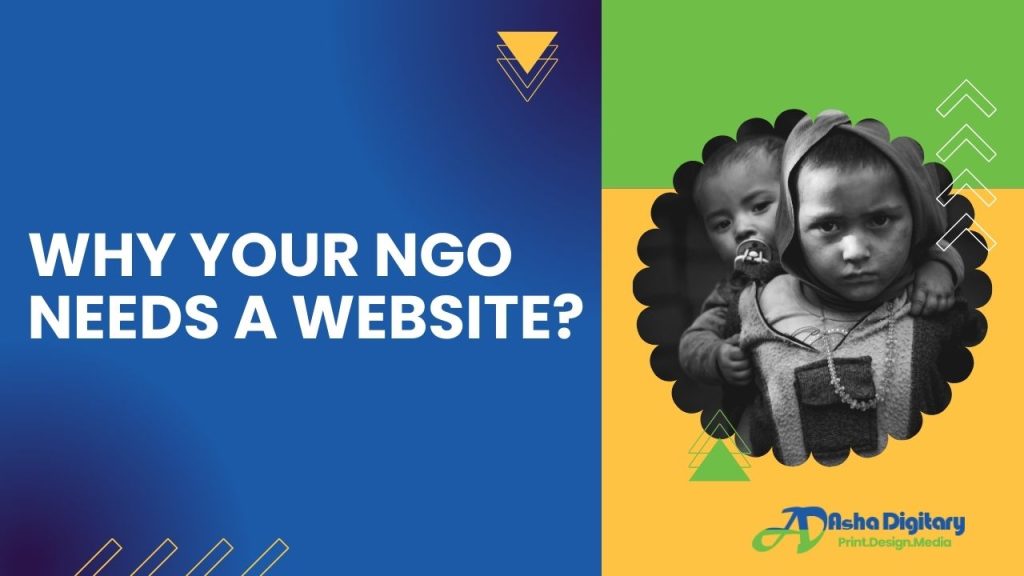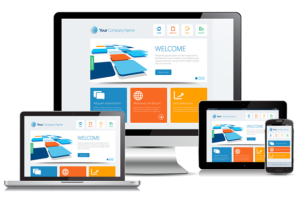Table of Contents
With the modern world being digitalized and almost every activity in the human’s life being engaged in the Internet it is quite crucial to ask such a question as whether the NGO in question needs a website. The answer to this question is a definite yes. Online presence is now a tool that has become very crucial for non-governmental organizations (NGOs) who are looking forward to making a change or expanding their companies’ outreach.
Why Your NGO Needs a Website
Amplifying Your Mission Online
A website then becomes the flagship of the organization where all its missions, visions, and objectives are communicated whenever there is a need to do so. As opposed to social media platforms where content often disappears in feeds, a website enables your organization to tell the story that may be told once or many times, anytime. It becomes the basis for every other communication the company makes whether on social media, company blog, email newsletters, etc.
Furthermore, a website makes it possible for your NGO to dictate what people get to see and hear from you. To lack an institutional archive throughout a time when fake news is rife means that there is no published information database through which the public, donors, and beneficiaries can access current, correct data about an organization.
Enhancing Visibility Through a Website
Reaching a Global Audience
Another advantage of developing a website for an NGO is the ability to share the NGO’s work with interested supporters all across the world. A major advantage of using a website in your organizational outreach is that, unlike other methods of contact which can be localized you can reach out globally. This is especially so because those NGOs are not limited to addressing issues of an area or region but rather work towards addressing international issues like climate change, poverty, or human rights violations among others.
As a result, the internet provides you with a tool, known as SEO, which makes your site to be listed on the list of options displayed whenever people are searching for something concerning your issue. For instance, if you are an NGO that specializes in the provision of clean water to the developing world, your website could benefit from more traffic because many people and organizations may be looking for that subject.
Building Credibility with a Professional Website
Trust and Transparency in the Digital Age
In the current world where trust is built through the online platform, a well-designed and professional website plays a big role in boosting the credibility of the NGO. For instance, prospective donors and volunteers are more likely to patronize those organizations that have well-organized and professional facades. A website is a way to prove its complete legitimacy, exhibit all the success stories, and the list of partners, and contain a detailed description of organizational finances and governance structure.
However, transparency can be considered as one of the key factors to build and consolidate trust. A website also permits the posting of annual reports audits, and impact assessments of a company and shows its stakeholders that resources are being managed properly. This point has the added effect of creating trust and sets out your NGO to other NGOs or organizations that might not be as transparent with what they do.
Boosting Donations with an Online Presence
Simplifying the Donation Process
The giving process has also been impacted by the introduction of the digital era where people prefer giving through means such as credit cards. A website enables your NGO to benefit from this trend by offering your NGO a safe and accessible online platform for donations. Donors can make contributions toward your cause with simple mouse clicks whether giving one-time payments or ongoing payments.
They can incorporate options like PayPal, Stripe, and even an option on cryptocurrencies to allow the various donors to comfortably contribute to the mission. Based on the above, the presence of a designated donation page on your website can also be enhanced for its intent to assist potential contributors by addressing some of the concerns that may come up and assuring the safety of the contributions.
Engaging Donors and Volunteers Through a Website
Creating a Community of Support
A website is not just a helpline; it is not just a place for one-way communication; it’s a place to build a community around a cause. Some of the common features are blogs, forums, or discussion boards that will allow the NGO to engage with supporters in a much more interactive way. These platforms enable donors and volunteers to post their experiences, query, and also post opinions about your particular cause, thus ensuring that all feel part of your noble initiative.
Also, with a website, it is easy to get target consumers and then classify them and or communicate to them accordingly. For example, you can ‘categorize’ the donors, volunteers, and beneficiaries to provide them with content and tools tailored to their needs. This is a very effective way of improving engagement while at the same time guaranteeing that your message is well received by the intended audiences.
Showcasing Your Impact with a Website
Highlighting Success Stories and Projects
There is perhaps nothing that mobilizes people and creates support than seeing the effects of a particular cause. Through a website, your NGO has an opportunity to have a platform where it can present success stories, ongoing projects, and even testimonies from the beneficiaries. Such stories have quantified and graphic illustrations, which make them tell testimonies of the impacts your organization is creating on the world.
Apart from the textual content, the ability to add videos, photograph galleries, infographics, etc makes the impact stories more comprehensible and interesting. In addition to Attention Control, these elements assist in translating the information into a more easily digestible form.
Cost-Effectiveness of a Website for NGOs
Reducing Marketing and Operational Costs
To NGOs, which mostly experience meager funding, cost efficiency is always a paramount factor. A website can be a very affordable method for marketing and operations because less money will be spent on flyers, brochures, and other kinds of advertising. The costs of website maintenance and updates are minimal after creating the website especially compared to other forms of marketing.
Additionally, many of your organization’s operations can be eased by a website. For instance, incorporating a Content Management System (CMS) enables the owner to easily upload new pieces of information such as news, events, and reports without having to involve a web developer. This independence not only reduces costs but also helps the organization to be always ready to adapt to new changes.
Leveraging Social Media Integration
Amplifying Reach and Engagement
Although having a website is key to an online presence, social media is crucial in directing visitors to the website and interacting with the larger audience. When using social media buttons and feeds on your website, your visitors can share your content, provide comments, or follow your organization’s various accounts.
The incorporation of social media also enables an NGO to create a unified brand for its outreach over integrated channels. Using social media to share content from your website means new people will come in contact with your message, new supporters, and potential traffic for your website where they can learn more about your cause and possible ways to support it.
Search Engine Optimization (SEO) for NGOs
Increasing Online Visibility
SEO is the major element in the promotion of the website and is indispensable when designing a website. Thus, search engine optimization helps to enhance the prospect of bringing people seeking topics associated with the mission of the NGO to your site. This entails proper keyword selection, producing good quality content as well as ensuring that the site’s technical aspects are well done.
To NGOs for example SEO is very essential because it creates a level ground for an NGO to compete with large organizations in the insight of search engines. First of all, with the help of SEO, your organization gains organic traffic and, therefore, people’s attention to your cause, which leads to more donations and more volunteers at your organization.
Using Analytics to Measure Impact
Data-Driven Decision Making
Web presence is good because it also facilitates monitoring of the audience and analysis of its behavior. There are tools out there such as Google Analytics and through its help, your NGO can know who your visitors are, how they got to your site, where they go, and what they look at most often. Having this data is crucial for proper strategic planning of your online activities as well as assessing the effectiveness of the measures you take.
For instance, if you analyze your statistics and find out that a certain blog post or a campaign page gets a lot of traffic, this is a great chance to write more on that subject or launch a campaign that targets those people. Likewise, if you have some of the pages that experience high bounce rates, you can look deeper into the problem and probably try to solve it by looking into the content and general usability.
Enhancing Communication Channels
Building Stronger Relationships with Stakeholders
To this end, communication should be considered as the key to most, if not all, NGOs today. A website is useful as much as it boosts your capability to interact with stakeholders—be it the donors, volunteers, beneficiaries, or the public at large. Through your website’s content, the reader can easily find out the missions and projects of the organization, as well as the current needs so no one who visits your site is left in the dark about the organization.
Furthermore, with a website, all the messages that are conveyed to the stakeholders can be managed in one place to provide the most relevant information. In each case, your website is the go-to source for updates on a new project, results of an impact report, or the launch of a fundraising campaign, and using it as such helps minimize the chances of mixed messages and the distribution of information to the wrong audience.
Customizing Content for Target Audiences
Tailoring Messages for Donors, Volunteers, and Beneficiaries
We must remember the fact that not all audiences are the same, and neither should a website with its content be. For example, one visitor may be more interested in a synopsis of the financial management of the nonprofit and the effect of his/her contribution while the other may want to know how to volunteer and what the process entails among other things. While beneficiaries may try to find out the kind of services that you offer and whether they are fit for them.
In this way, for every type of audience that visits your website, you would be dividing your content in such a manner that it addresses the specific needs of each segment. It does not only enhance the experience of the end user but at the same time enhances the probability of getting people to respond and get the needed number of beneficiaries, volunteers, or people to give out their donations.
Accessibility and Inclusivity in Web Design
Ensuring Your Website is Open to All
Another important principle for NGOs where your website should conform to is persons with disabilities – your site must be accessible for them. This is about compliance with the accessibility in web design procedures, for example, incorporating descriptions to images, making the site operable by just using a keyboard, and creating readable content.
Furthermore, the design of the website should cater to the differing requirements of its users by providing language translations, flexible text sizes, and contrasted color choices for blind users. If your business website is optimized for visitors with disabilities, it at the same time increases the coverage area and improves the image of the organization.
Security Considerations for NGO Websites
Protecting Sensitive Data and Building Trust
Security is an important consideration for any organization that operates and has a web presence and this is also true for NGO’s. Ensuring that your website is secure is critical, especially for the protection of the information belonging to your donors, volunteers, and beneficiaries. This includes enabling HTTPS, use of passwords, and frequent updates of one’s site to block vulnerabilities.
Moreover, communicating about your security enhances users’ privacy, which helps to gain their confidence. People risk having their accounts hacked, or their personal details and card details stolen when donating online or inputting their data on the internet. One can therefore develop the practice of communicating security measures taken by the organization and use payment processors that can be trusted to process visitors’ information hence promoting engagement and donations.
The Role of Blogs in NGO Advocacy
Sharing Insights, Updates, and Calls to Action
Through a blog, your NGO can continue providing more details and exposition on different issues, processes, and activities, as well as the proliferation of calls to action. Through a blog, you can disseminate information to your audience and keep them informed on new trends in your field, give an opinion on issues that may be of importance, and bring the audience to contribute to your cause through donations, volunteering, and word around.
Also, blogs are important for content marketing since they contribute to increasing your website’s ranking and attracting organic traffic. This guide illustrates various methods that can be used to create well-formatted, keyword-well-fitted content that will enable users to visit your site and become the champions of your cause.
Creating a Volunteer Portal
Simplifying Volunteer Recruitment and Management
People are the backbone of NGOs because they offer the human resources and energy that will enable you to execute your vision. Having an online volunteer recruitment and management system on the website can be very instrumental in facilitating and organizing the process of volunteer recruitment as well as the management of volunteers’ work.
Other information that may be contained in a volunteer portal may be sign-up forms, a calendar to show events and dates, training materials, or working guides. You can add value to volunteers’ experience, help them through such web pages, and thus maintain an increased level of effectiveness and commitment from volunteers.
The Impact of Mobile-Friendly Design
Reaching Users on All Devices
This means making sure that your website is mobile-friendly since the world is gradually becoming mobile. Responsive design that allows a site to adjust to different displays enhances the experience and also provides access to more people. Since most visitors use their mobile devices to browse the internet, a mobile-optimized site is important in targeting users wherever they are.
Also, the use of a website that is optimized for mobile enhances SEO as search engines such as Google will rank websites that are mobile-friendly well to the top. This may result in an increased number of views and thus exposure enough to put your NGO and achieve its set goals and objectives.
Legal and Ethical Considerations for NGO Websites
Compliance with Laws and Ethical Standards
Just like with any other website, there are certain legal and ethical requirements to consider when managing an NGO’s web resource: data protection laws like GDPR, adherence to which is mandatory; and non-misleading content. Breaking the laid down standards will lead to legal implications as well as create a negative image for the organization.
One has to be mindful of the legal reigns in the areas of operations and ensure that one’s website does not infringe the set rules. This may include ensuring that your site complies with the set privacy policies, obtaining permission to collect data from the users, and more importantly, ensuring that the content you display on the website is legal and does not in any way exploit the targeted communities.
Integrating Online Payment Systems
Facilitating Secure and Easy Transactions
However, to enhance the efficiency of online fundraising, it is necessary to implement viable and secure systems of payments on the site. Such a system should include several payment options such as credit cards, direct bank transfers, and digital wallets, that is, those that are acceptable to your donors.
Also, working with a reliable payment processor that meets security standards (PCI DSS) will help to gain the trust of the audience and minimize the risk of developing fraud. The easier and safer the process a person donates, the more chances your NGO gets for receiving the donations and helping the cause.
The Power of Multimedia on Your NGO Website
Using Images, Videos, and Podcasts to Tell Your Story
Adding images, videos, and podcasts to the overall content does make a great difference to the NGO’s message and how it is presented. Most of the time people prefer visuals rather than plain words and this is an effective way of passing your feelings about your work to your readers.
For instance, a video of a recently accomplished project or an audio clip that captures interviews with beneficiaries will be strong proof of your organization. These multimedia elements can also be put on social media accounts and ensure they get to the larger populace thus mobilizing more supporters.
Building a Newsletter Subscriber Base
Keeping Your Audience Informed and Engaged
Email newsletter is one of the best ways to constantly stay in touch with your fans. Website subscriptions are direct links to your targeted audience as they can easily convey your newsletter, and other related updates of your organization’s current and future activities, events, and fundraising activities, among others.
A well-produced newsletter can also help to enhance topicality by offering members inside stories or account access to early registration to events. It also can be used to send targeted newsletters to encourage people to learn more about your endeavors on your website.
How a Website Can Support Fundraising Campaigns
Running Effective Online Fundraisers
As revealed above, fundraising constitutes a central part of any NGO’s functions, and a website is a valuable tool in this process. With separate pages for your campaigns, your NGO will be able to offer information on the various campaigns such as the objectives and timelines of the campaign and the impact that the campaign will have on the donated funds.
The integrated online fundraising campaigns can also be customized with features such as; % complete, Donors Wall, and Matching Gifts. These elements do not only entice people to donate but also foster togetherness of people in support of the campaign, this draws more people in towards the cause and the eventual completion of the aim.
Collaborating with Other NGOs Online
Building Partnerships and Networks
Your presence here is a good way of deepening your reach and creating partnership opportunities with other NGOs here in the local and international arena through the website. Incorporating links to partner organizations, joint endeavors, and projects into your website design is a good way to prove that you are a part of the joint struggle for a particular course.
Furthermore, your website can help you network online with other NGOs by offering tools whereby others can contact you, exchange successful strategies, and learn about potential cooperation. Not only do your organization and the specific project benefit from this approach but the nonprofit sector as a whole is also made significantly more efficient.
Using Testimonials to Build Trust
Featuring Donor and Beneficiary Testimonials
Testimonials from donors, volunteers, and beneficiaries can be powerful tools for building trust and credibility. By featuring these stories on your website, you provide social proof that your organization is making a real difference. These testimonials can be presented in various formats, including written quotes, video interviews, and case studies.
Including testimonials on key pages, such as your donation page or volunteer sign-up form, can also serve as a persuasive element that encourages visitors to take action. When people see that others have had positive experiences with your NGO, they are more likely to feel confident in their decision to support your cause.
Implementing Content Management Systems (CMS)
Simplifying Website Updates and Maintenance
The most critical tool when it comes to managing your NGO’s website is what is commonly referred to as a Content Management System (CMS). It also enables changes in contents and features like new pages as well as incorporation of media without professional coders. This makes it possible to ensure you always have an up-to-date website to reflect changes occurring in your organization.
Using a CMS, the control of different sections of your site can be handed out to different members of staff to update the site as often as possible. But this also helps an organization to respond proactively to new opportunities, threats, and even changes in the external environment.
The Role of a Website in Crisis Management
Communicating Effectively During Emergencies
Crises occur from time to time, and your website can help you cope with them if you make efficient communication your priority. Regardless of whether the situation is a natural calamity, a SAR outbreak, or an organizational mishap, your website can be utilized as a tool for disseminating truthful information to your stakeholders.
Availability of this information, contacts, and other resources on your website can reduce the flow of information and rumors or false information among patients. Further, a crisis management plan that identifies standard procedures for website communication will help your organization to be ready to respond to any situation as and when it occurs.
Showcasing Your NGO’s History and Legacy
Preserving and Sharing Your Organization’s Journey
This is true because the history and the background of an NGO form part of its personality, and a website is a tool through which the journey of the NGO can be taken. Every business owner who established an organization should take time and develop a special page on his website that will contain information on the formation of the organization, activities, and achievements.
Apart from the purpose of instructing new visitors about your organization’s history, this content also helps to build up your credibility and assure visitors of your organization’s durability. It can also be motivating to your team and all the supporters reminding them of the strides you have made and the accomplishments that have been made.
Using a Website for Event Promotion
Driving Attendance and Participation
Fairs and other similar activities are normally part of the regular activities of most NGOs in terms of outreach and fundraising, and these are well suited for web presence through your website. To achieve awareness and get people interested in attending your events, you should make event pages with descriptions, registration forms, and other fixtures such as posters, invitations, etc.
In the same way, social media and participating through emails for the events also help in the improvement of promoting events to a wider level. Whether you are attending a gala, a workshop, or even an online webinar you want your audience to take part and your site can provide them with the means to do so. Events are a key part of many NGOs’ outreach and fundraising efforts, and your website is an ideal platform for promoting these activities. By creating event pages with detailed information, registration forms, and promotional materials, you can drive attendance and encourage participation.
Additionally, integrating your event promotion with social media and email marketing can amplify your reach and ensure that your events are well-publicized. Whether you’re hosting a gala, a workshop, or an online webinar, your website can be the central hub for all event-related activities, making it easier for your audience to get involved.
The Future of NGO Websites: Trends and Innovations
Staying Ahead with Technology
It is vital to remember that your NGO’s website is not a set-and-forget strategy as technology gets smarter so should your site. The best practices in web design, user experience, and digital marketing can be useful for your organization to keep up the pace with the current tendencies and innovations. This could include implementing new features, including artificial intelligence into your service, increasing the interactiveness of your site, or seeking new ways of reaching your audience.
When you make it a habit to go through your website and act on necessary changes, specifically the trends that you follow in your site, then your NGO will always operate in the limelight of nonprofit agencies. Not only does this forward-thinking approach enhance your organization’s online presence but it also places your organization ahead of the pack ready for the chances and risks in the future.
FAQs
What are the primary benefits of having a website for an NGO?
A website is used to boost visibility, gain credibility, ease donations, and encourage the stakeholders by creating a platform for them to relate to.
In this paper, one would want to know how a given website can contribute to the improved growth of donations for an NGO.
Ideally, a website brings the process of donating closer by providing secure online payment procedures as well as a clear signifying the effectiveness of the donations.
Why is SEO important for NGO websites?
It increases website traffic; it means when people type specific topics in the search engine, they will come across your NGO hence drawing more support.
What role does social media integration play in an NGO’s website?
Social media integration increases its possibilities to reach and interact with the audience through traffic redirecting and branding.
There is, therefore, the question of how a website can benefit volunteer recruitment.
These challenges can be solved by creating an online platform through which volunteers can register, get the necessary information, and regularly learn about new vacancies.
What are the legal considerations for NGO websites?
Since the websites of NGOs function in principles of transparency, they must adhere to the data protection laws, and ethical standards and seek to ensure that the contents posted are factual to avoid legal repercussions.









